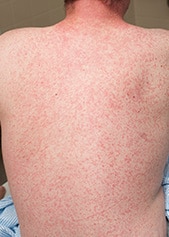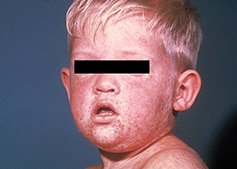PDF 214 KB
Measles information - an illness caused by infection with the measles virus. It is spread when an infected person talks, breathes, coughs or sneezes tiny particles.
Measles is an illness caused by infection with the measles virus.
Measles is a notifiable condition1
Measles is spread when an infected person talks, breathes, coughs or sneezes tiny particles containing infectious agents into the air. These are called small particle aerosols. Due to their tiny size, small particle aerosols can travel long distances on air currents and remain suspended in the air for minutes to hours. These small particle aerosols may be breathed in by another person. Measles is also spread by contact with hands, tissues and other articles soiled by nose and throat discharges. The virus is very infectious and droplets in the air may infect people entering a room up to 30 minutes after an infected person has left it.
Until the late 1960s almost everyone caught measles during childhood in Australia. As a result almost all people born in Australia before 1966 are immune to measles.
The gradual introduction of measles vaccine since then has resulted in the average age of cases in Australia increasing. Most cases now occur in people aged older than 20 years.
Outbreaks in recent years have followed the introduction of the virus from outside Australia.
 Early in the infection, symptoms may include:
Early in the infection, symptoms may include:
 These symptoms usually worsen over 3 to 5 days, then a blotchy rash (see image) begins on the head and over the next day or two spreads down the entire body.
These symptoms usually worsen over 3 to 5 days, then a blotchy rash (see image) begins on the head and over the next day or two spreads down the entire body.
The rash lasts 4 to 7 days. Measles illness usually lasts about 10 days. The cough may be the last symptom to disappear.
Measles is often a severe disease, frequently followed by middle ear infection (7% of cases) or bacterial pneumonia (lung infection or inflammation) in 6% of cases. In as many as 1 in every 1000 cases, brain infection occurs (encephalitis), often resulting in death or permanent brain damage. Sometimes brain damage may not appear until many years later.
Complications from measles are more common and more severe in the chronically ill and in very young children.
The diagnosis is suspected from the clinical presentation and can be confirmed by a blood test, or detection of the virus in urine, throat or eye specimens.
(time between becoming infected and developing symptoms)
Usually 10 days to onset of fever (range 7 to 18 days) and about 14 days to onset of rash.
(time during which an infected person can infect others)
From 24 hours before the onset of symptoms to four days after the appearance of the rash.
There is no specific antiviral treatment for measles. Complications may require antibiotic treatment. Treatment for the symptoms includes plenty of fluids and paracetamol for the fever. Aspirin should not be given to children under 12 years of age unless specifically recommended by a doctor.
Exclude the person with measles from childcare, preschool, school and work for at least 4 days after the onset of the rash.
Exclusion periods for contacts*:
*A contact is any person who has been close enough to an infected person to be at risk of having acquired the infection from that person.
1 – In South Australia the law requires doctors and laboratories to report some infections or diseases to SA Health. These infections or diseases are commonly referred to as 'notifiable conditions'.
Image — back of boy with measles. Image courtesy Prof. David Gordon, Flinders Medical Centre, Adelaide, South Australia.
Image - Face of boy with measles; third day of rash. Image Courtesy of Public Health Image Library (PHIL), Department of Health and Human Services, Centers for Disease Control and Prevention (CDC-USA)